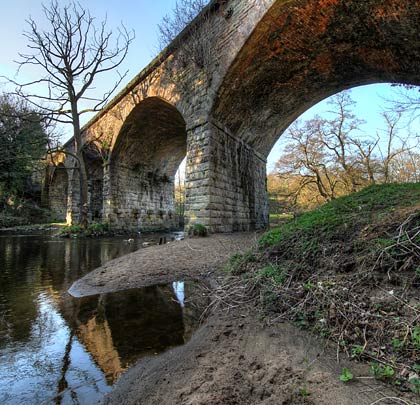Rowsley Viaduct
Rowsley Viaduct


















In engineering terms, the Midland’s Rowsley-Buxton line was one of the country’s most spectacular. Built between 1860 and 1863, it featured a series of viaducts, tunnels and cuttings, accommodating the railway as it passed up the often steep-sided and meandering Wye Valley.
The line was an extension of Manchester Buxton Matlock & MIdland Junction Railway, the first phase of which opened in 1849 between Ambergate and Rowsley. Progress beyond stalled thanks to financial difficulties and the London & North Western’s determination to block the Midland’s aspiration of tapping into the lucrative rail market around Manchester, but the door was unlocked in May 1860 with Royal Assent for the extension plans.
Rowsley’s original station had been sited for an onwards alignment up the Derwent Valley, northwards towards Chatsworth, but this was altered when the Duke of Rutland made clear his support for a westerly route through the Haddon Estate and into Bakewell. This required the construction of a replacement station on the new line which branched off about 400 yards south of the original terminus.
About 600 yards beyond the junction, the first substantial structure encountered was the four-arch Rowsley Viaduct across the River Derwent, together with a retained embankment and underbridge at its western end. It opened to traffic on 1st August 1862 and carried its last train on the evening of Saturday 29th June 1968.
The main structure curves to the south and comprises substantial coursed gritstone with rock-faced dressings. The four spans feature segmental arches, springing from imposts set on rectangular piers which have cutwaters on their upsteam side. The low parapets sit on plain band courses and host sets of railing. The abutments are supported by buttresses.
Immediately beyond the viaduct, a 20-yard section of the approach embankment is faced with a vertical masonry retaining wall on its northern side. Adjacent to this is the single span Duke’s Bridge under which passes a track heading to the Duke of Devonshire’s Chatsworth Estate. The arched opening is also flanked by buttresses, with a curved wingwall acting as a retainer for the embankment that extends westwards.
Owned by the Derbyshire Dales District Council and leased to Peak Rail, the viaduct is protected by palisade fencing at the western end of its deck, erected in the late Noughties. The land beyond was transferred back the Haddon Estate in the mid-1980s.
It is the aspiration of Peak Rail to relay the line across the viaduct and onwards up the valley towards Buxton. An immediate obstruction is presented by the dismantled bridge over the A6 – between the viaduct and the old station site – and the subsequent raising of the road level. The Haddon Estate is also opposed to the railway’s reinstatement. Another possible use for the structure would be to carry an extension of the popular Monsal Trail. The Council is currently evaluating options for this.
Rowsley Viaduct is Grade II listed and in need of some work to remove vegetation and saplings. Several pattress plates and tie bars have been inserted just below parapet level to help arrest lateral movement.







